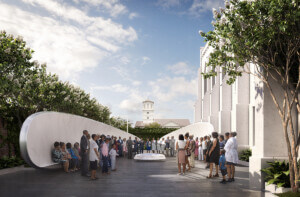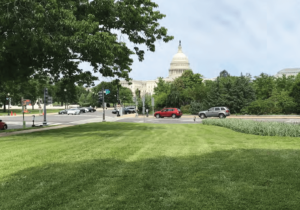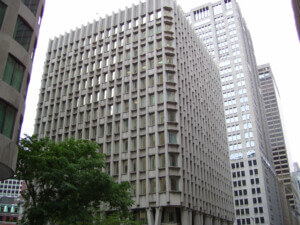The Egg Church. The Church of Tomorrow. An “honest architecture” that’s forever contemporary.
Since its opening around Christmas in 1956, these are a few phrases that have been used to describe First Christian Church, a historic, organic modernist building in Oklahoma City. Designed by the then-young local firm, Conner & Pojezny, the 32-acre project quickly became a state treasure and was lauded as a major engineering feat by Life Magazine, Newsweek, and Architectural Record.
The dramatic, concrete domed church—which has a mid-century Jetsons look—is newly in danger as its current owners aim to sell it to a buyer with plans to demolish the community icon. Oklahoma’s News 4 reported that dozens of demonstrators crowded outside First Christian Church last week in protest. Those in attendance included the executive director of Preservation Oklahoma and members of Okie Mod Squad, a group led by one of the church’s architect’s granddaughters, Lynne Rostochil.
Representatives told News 4 they’re worried the building might be knocked down once it’s successfully sold; the property went on the market in 2016 and only recently snagged attention from buyers when the asking price was drastically lowered from $8.2 million to $5.65 million. The broker behind the sale hopes it’ll become a mixed-use development.
Many mid-century structures around Oklahoma City have come under threat in recent years. One of those was Founders National Bank, a Bob Bowlby–designed structure that boasted two, 50-foot exterior arches, It was leveled last October. Like R. Duane Conner and Fred Pojezny, who designed First Christian Church, Bowlby came out of an era in which architectural education in Oklahoma was transforming the industry.
Bowlby studied at the University of Oklahoma under the direction of famous American architect Bruce Goff who was internationally known for his expressive, organic designs and for creating an innovative program with the school’s architecture department. Because of Goff’s widespread influence, as well as the work coming out of Oklahoma A&M where Conner and Pojezny graduated, the city benefited from a slew of forward-thinking pieces of architecture, many of which have just surpassed or are nearing historic-designation age, meaning they’re potentially endangered if not in use.
As a reminder… we’d love to have your support at the next City Council meeting where Councilman Ed Shadid will make the motion to begin the process of declaring First Christian Church a landmark! It’s at 8:30 a.m. on March 12th at City Hall, 200 N. Walker #FirstChristianChurch pic.twitter.com/wyCbkK64PF
— AIA Central Oklahoma (@AIACOC) March 7, 2019
In order to protect First Christian Church, a Change.org petition started by Okie Mod Squad has been circulating that urges city council members to officially landmark the building, a designation that would require future development on the site to go through a public approvals process. Rostochil noted in a February post that thought the building was put on the National Register of Historic Places in 2011, this “in no way protects it from being demolished.” The move only now qualifies it for tax credits to repurpose or restore the structure.
The efforts of the “Save the Egg” protestors have resulted in a city council meeting happening on Tuesday, according to News 4, where local lawmakers will discuss whether or not the church can potentially be declared a landmark. If identified as such by the Historic Preservation Commission, then the new buyer would not be able to make significant changes to its original design without prior approval from the city’s Historic Preservation Commission. The protections would include the entirety of the Edgemere Park property, not just the iconic, egg-shaped main sanctuary. Conner and Pojezny designed three additional structures on the church’s campus, including a four-story education building and a small fine arts complex known as the Jewel Box Theatre, the city’s oldest, continuously-operating community playhouse.
It took the architects three separate tries over several years to come up with the current design for the $2.1 million development, which the church’s renowned minister, Bill Alexander, wanted to be a “Church for Tomorrow.” In an old newspaper clipping cited on Okcmod.com, the design team said they aimed to take a “decided departure from conventional church construction” by building an “honest architecture” that would make it forever contemporary.
For residents in Oklahoma City, not only does First Christian Church reflect the history and character of the region’s modern architectural landscape, but it also serves as a place of spiritual solace and refuge in tough times. In October of 1995, families gathered there after a terrorist struck a downtown federal building, killing 168 people and injuring over 600 others. The bombing remains one of the deadliest terrorist attacks in U.S. history and to many locals, First Christian Church stands as a memorial to community healing.











